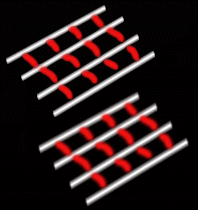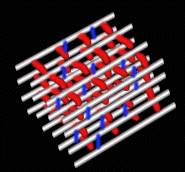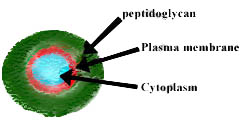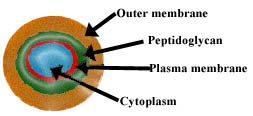
Download
the
Power
point Presentation
The outer surfaces of a cell is generally classified
as the Cell Wall. In bacteria, cell walls typically fall into 1
of two categories, Gram positive and Gram negative. The name comes from
a test to determine cell
wall type in which the different cell walls pick
up different
stains. Although the difference between a Gram
negative and positive may seem small, it has
significant influence
on how the bacteria survives, what the bacteria
can tolerate,
and many other influences.
Part I
Peptidoglycan is a substance possessed by both Gram positive and Gram negative bacteria. It is a structure composed of carbohydrates, proteins, and teichoic acids, which combine to form a dense lattice structure.


White bars are carbohydrates, Red bars are peptide bonds,
and blue bars are teichoic acids

Gram positive bacteria differ from gram negative in that they posses a plasma membrane surrounded only by peptidoglycan. It is the thick, dense peptidoglycan layer that affords the gram positive bacteria relatively more protection then its gram negative counterpart.

Gram negative bacteria include E. coli, Serratia, & others. Generally
these bacteria can only exist in moist environments. They differ from Gram
positive bacteria in that they possess a reduced peptidoglycan layer, but
they do possess an outer membrane, which does serve as some protection
for the bacterial cell, as it protects in other ways, (i.e. possessing
a negative charge to drive away anything with a positive charge {electrostatic
defense})